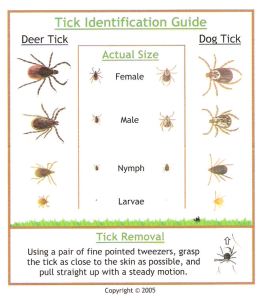Ticks are small insects that feed on the blood of a host by using their mouths to latch onto the skin. According to WebMD, most tick bites do not cause serious health problems, but it is important to remove a tick from your skin as soon as you notice it. Ticks can transport bacteria and diseases, including Lyme disease, and a risk of infection increases 24 to 72 hours after the tick attaches to the skin.
Instructions
-
-
Use the tweezers to grasp the tick firmly by its head or mouth. Firmly grab the part of the tick that is closest to your skin without tearing the insect’s head from its body. Do not grab the tick around its belly as this could result in you squeezing fluid into your body.
-
Pull the tick away from your skin with a firm, steady motion. Pull the tick straight out. Do not use a twisting motion. Avoid crushing the tick but do not become alarmed if the tick’s mouth parts remain in the skin after the body is removed.
-
Throw the tick into the trash or place it in the jar or plastic bag if you wish to have a medical professional inspect the insect. Use the soap and water to lather and clean the affected area as well as your hands.
Tips & Warnings
-
If you crush the tick while attempting removal, clean your skin with soap and water or rubbing alcohol.
-
Examine your skin and scalp for ticks when returning from areas where ticks might live, such as heavily wooded locations. Examine your pets as well.
-
Do not use petroleum jelly, a hot match, gasoline, rubbing alcohol or nail polish to remove a tick. These methods can cause the tick to burrow deeper into the skin and release more saliva. Watch for signs of skin infection after a tick bite. Signs include swelling, redness, pus and skin that is warm to the touch.
-
-


 Hi there. I’m Grace. I am a very hard working, compassionate and strong willed woman who loves a challenge and never backs down from a hard days work, which is a good mix for working with dogs that are having trouble getting along in the world with us humans! The greatest reward I get in life is when someone tells me I saved the life of their dog so they didn’t have to give it up! I love nothing more then showing people how to be a leader in their own world and all aspects of life! I am a leader, and walk my own path in life and I’ll go where ever it takes me!
Hi there. I’m Grace. I am a very hard working, compassionate and strong willed woman who loves a challenge and never backs down from a hard days work, which is a good mix for working with dogs that are having trouble getting along in the world with us humans! The greatest reward I get in life is when someone tells me I saved the life of their dog so they didn’t have to give it up! I love nothing more then showing people how to be a leader in their own world and all aspects of life! I am a leader, and walk my own path in life and I’ll go where ever it takes me!
Trackbacks/Pingbacks